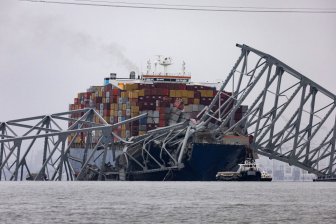Achi news desk-
The recent demise of Lynx Air leaves only Flair Airlines holding the flag for ultra-low cost carriers in Canadian airspace.
Heading into the busy summer travel season when airlines make a lot of their money, some experts say travelers booking tickets across Canada will have to weigh cheap airfares against reputational uncertainty and financial that raises Flair.
The Edmonton-based carrier’s CEO tells Global News he is confident the airline has a place among “price-sensitive” consumers, but experts say Flair faces headwinds in making the price model very low cost of working in Canada.
Calgary-based Lynx Air announced at the end of February that it would close shop and file to protect creditors. Filings show Lynx had hoped an acquisition by rival Flair would help it avoid bankruptcy, and Flair has said it is eyeing Lynx jets in plans to grow its own fleet.

Stephen Jones, CEO of Flair Airlines, says it was a “sad day” when Lynx left the market. He says he feels for the people at Lynx, especially because they have the shared vision of bringing the very low cost carrier or “ULCC” model to Canada that has worked well in Europe and the US states
But Jones tells Global News that he is not discouraged to see another company with the same model collapse. Flair has seen a “big increase” in demand for his seats since Lynx’s departure, he said.
“We’re the only low-cost carrier left in the market, and it’s a great place to be. We have the price-sensitive leisure market here, frankly, to ourselves,” he said.
Low-cost flight options are limited outside Flair in Canada between Air Canada’s Rouge banner and WestJet’s Swoop, which it absorbed last year. WestJet also plans to spin off Sunwing and integrate the low-cost carrier into its core business by October. Canada Jetlines also flies primarily to warm weather destinations out of a few Canadian hubs.
While Flair has been a Canadian outdoor player for over two decades, its modern iteration as a ULCC began with its rebrand in 2019. Lynx Air, once known as Enerjet, took to the skies as a low-cost carrier during the COVID -19 pandemic at the end of 2021 and folding a few years later.
Jones argues that Lynx did not have the time to build the “economies of scale” needed to succeed in the Canadian market. He says the failure of Lynx has no bearing on whether the same business model can succeed under Flair.
“There’s nothing about Canada that says the ULCC model shouldn’t work. People love to travel and people love a deal,” he said.
The challenges of the low cost model in Canada
Jacques Roy, a professor with the logistics and operations management department at HEC Montreal, tells Global News that “it’s very difficult to operate a low-cost airline model in Canada.”
The low-cost model that started with Southwest Airlines in the US and later spread to Europe relies on having reliable “city pairs” where airlines can squeeze many seats into a suitable aircraft to lower their cost per customer enough to drive the price down. of airfare, said Roy.
The distances between Canadian cities can mean a less comfortable trip for longer, he said, which affects the value proposition for domestic travel.
Weighing the bottom line for all air carriers in Canada are costly airport improvement fees that make domestic takeoff and landing a significant expense eating away at airlines’ margins, Roy said.

Flair himself has acknowledged the impact of landing fees at Canadian airports.
Financial news and insights delivered to your email every Saturday.
In moving its spring schedule to reduce its overall number of flights but boost service to sun destinations outside the country, the airline indicated in a statement to Global News last week that it was saving more money on the longer journeys. Flair also said it was responding to Canadians’ demand for more sun resorts during the spring months.
Jones says that the high fees charged on Canadian air travel are unique to the market, and that ultimately means that those costs are paid by the customer in the price of a plane ticket.
“The fact that the airport fees are high here means that people, on the margins, will choose not to travel because they can’t afford it,” he said.
Duncan Dee, Air Canada’s former chief operating officer, says the decision to abandon Canadian destinations in the spring season “absolutely” makes sense in terms of reducing airport fees.
Airlines are charged about $50 per passenger when they take off and when they land at various airports in Canada, he said, a fee that Flair can effectively cut in half each time if he flies an international route.
The high airport improvement fees associated with Canadian hubs is a major reason why Dee believes it is “extremely difficult” for the ULCC model to work on a large scale in the country.
“What you end up with is a very, very high starting point for a lot of these very low-cost carriers, price-wise,” he said.
“It is almost impossible for ultra-low-cost carriers like Flair to take a page out of their counterparts in America, Europe and Asia, who can use ultra-low fares to stimulate the market.”
Dee says Lynx’s failure reflects the need for change in the Canadian market, which he says is the only one in the world where air travel infrastructure “is 100 per cent funded by fees and taxes levied, in the eventually, on the leaflets. “
Flair has faced a number of public legal and financial challenges in recent years, although CEO Jones says much of the turmoil facing the airline is behind him.
Flair’s Canadian-made bona fides have been up in the air for months amid an investigation by the Canadian Transport Agency, which ultimately ruled that the airline had met the requirements for Canadian ownership in June 2022.
The company faced a seizure order for its property from the federal government back in November related to $67.2 million in unpaid taxes. Jones confirmed to Global News that the airline still has a plan to pay that amount to the Canada Revenue Agency, saying the company has a “good relationship” with the tax authority.

A year ago, a number of Flair planes were seized by its jet lease manager who claimed the airline was behind on its payments there too; Flair has since sued that company and its lessees. Jones claims the seizure is “illegal” and says the company’s current fleet of 20 jets is “100 percent secured.”
And just last weekend, Flair faced a technical issue that brought its booking platform down for several days until Tuesday when services were up and running again.
Jones says the downtime is related to a change of payment providers and that there were no flight disruptions related to the problem.
Although Flair previously said he was having a financial dispute involving his payment processor, the Peoples Trust, Jones says that has been resolved and Flair is back working with the financial services company of Vancouver.
Until speaking to Global News on Wednesday, Flair had not publicly said what caused the outage on his website.

Dee says headlines about Flair’s financial or technical difficulties can be difficult for the company to bounce back from in the eyes of customers.
“It is easy for consumers to lose confidence in an airline that has an inability to manage its own communications and an inability to publicly address many of the concerns that have been raised by the media,” he said. .
Jones does not believe that Flair is losing its appeal in the eyes of customers, pointing to a surge of new flight bookings on Tuesday when the company’s system came back online. It was the company’s “biggest sales day ever,” he said.
“The consumers, I think they are voting with their feet,” he said. “People were waiting for our system to come back online and they were hungry.”
Dawn serves ‘price sensitive customers’
Consumers are “absolutely price sensitive” at the moment after a long bout of high inflation and a rapid jump in interest rates over the past two years, Jones said.
“In a world where affordability is one of the biggest challenges for everyone, having some competition in the airline market is critical for them,” he said.
Dee isn’t convinced that Flair has found his niche in the market yet. He says the airline is helping to reduce bids from rivals on the routes it serves, but is limited in how much it can undercut WestJet and Air Canada and is not yet broad enough to have “huge impact” on the prices consumers pay. .
And in cases where flyers can save some money on their tickets, he says some travelers may still choose to stick with the larger airlines if they have accumulated points in their loyalty programs.
Roy also says he believes many passengers might forgo Flair and spring for some extra legroom on longer flights in Canada.

But he agrees with Jones that consumers are price sensitive at the moment, and are increasingly looking at flights as a means to an end.
“They want to get there as quickly and as cheaply as possible,” he said.
Despite the challenges of the ULCC model, Roy is optimistic that Flair can become a viable third option for the Air Canada-WestJet duo.
“I hope they succeed, because I would like a third airline in some of the Canadian markets. It would really provide for more competition,” he said.
Unsurprisingly, Jones’ own outlook for the airline is rosy. He tells Global News that the sky is clear for the ultra-low-cost carrier, with expectations for a strong summer season and a runway to increase the company’s fleet again starting in 2025.
“I think it’s going to be a busy summer for all airlines, but certainly for Flair,” he said.
“We have great prices out there. We have some really great destinations. And I think this will be our best season ever.”



